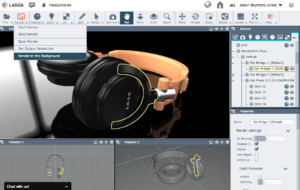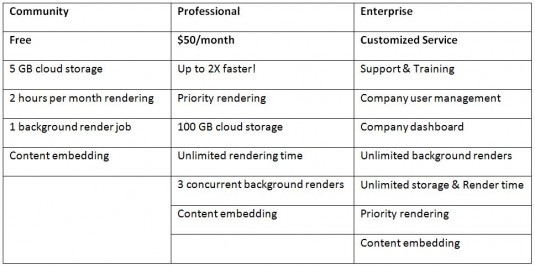The Montreal-based cloud rendering company has been making friends in varied places.
There’s a fierce arms race going on in the cloud, where companies seek out territory in building 3D tools for use in the cloud. It really is the next frontier, or maybe the better term is gold rush. So many companies are building products that it’s getting increasingly difficult to stand out. Rendering has popped up as a capability well suited to the cloud because it only benefits as more processors are put on the job. Lagoa Technologies, based in Boston, Bonn, and Montreal, is building an online rendering tool, which will let users upload files and have their projects rendering while they get on with their lives. It’s not a new idea, but Lagoa has been working on their projects from two points of view. They’re working with the design communities and teaming up with companies like SpaceClaim and GrabCAD to put together options for modeling and collaboration. The company attended SolidWorks World—where we caught up with them—to introduce themselves to the design community and show the depth of their technology portfolio.
The company was founded by three scientists with interests in 3D technology, Thiago Costa, Dov Amihod, and Arno Zinke. They debuted at Siggraph 2012 as TeamUp with their multi-optics renderer developed at the University of Bonn by Zinke. Lagoa’s renderer offers physically based materials for users who can upload their models in standard formats such as OBJ, 3DS, PLY, STL, DAE, LWO, etc. Lagoa also offers standard models for users to try out. The Lagoa renderer is an unbiased interactive renderer which lets users interoperate with the model as it is rendering. They can change materials, colors, on the fly. As such it is part of a new generation of renderers that have emerged as processors have evolved to handle massively parallel tasks. Members of the very crotchety family include Arnold, which is being increasingly used in the film industry, Nvidia iRay, Luxion Keyshot, Maxwell Renderer, V-Ray RT, and many more. Non-biased renderers were born for the cloud, they devour processing cycles; the more the better. Most renderers combine biased and non-biased techniques as a matter of practicality after all.

But the cloud has other benefits for creative people. It fosters collaboration. Multiple people can work on the same assets and review changes. On the developer side, Thiago Costa has said in his blog, he has longed for a way to be able to respond to requests, make changes in the software, and add updates as they become available. The cloud makes this possible as well.
Costa’s path to Lagoa has taken him through content creation as a freelancer, game development at Ubisoft, and on to tool development. Costa developed the Lagoa Multiphysics tool, which was licensed to Autodesk for Softimage; these days Costa’s multiphysics tool comes up frequently in conversation with Lagoa, both as a reference and as an example of further work they could do. Lagoa’s founders are joined by scientists and engineers from Autodesk, Google, and Softimage. Amihod worked at graphics pioneer Matrox and Bluestreak. VP of Marketing Chris Williams comes from Vuuch and took his company Seemage into an acquisition by Dassault. The team knows a lot of the right people, and the ranks are filled out by graduates from McGill, University of Bonn, and University of Waterloo.
In addition, the company offers an API to enable other companies to easily bolt on Lagoa’s capabilities. Those capabilities are likely to expand as the company gets new investment.

What do we think?
The cloud boom is an extension of the app boom and both trends challenge the incumbents. The app makers are making easy-to-use perfectly realized apps that accomplish limited but valued tasks. The cloud adds collaboration, the ability to store and share content, and update applications proactively. As we’re seeing from the growing interrelationships between cloud companies like GrabCAD and Lagoa and evolving companies like SpaceClaim, there are opportunities in providing customers with easy options that they can try, buy, or subscribe.
Companies working directly with Lagoa are able to create custom applications and there is clear interest in creating something like configurators as Lagoa shows in this sample app. For the average hobbyists or light CAD user, Lagoa’s interface is a tad opaque but thanks to simple online tutorials it’s easy to get up and running.
This is a company with big ambitions, and with fresh funding under its belt. The company announced a $5.3 million round of funding from Atlas Ventures and Siemens.
As we were talking to the people from Lagoa Technologies, we were also hearing about the Ottawa based company Clara.io, which is courting the entertainment side of the 3D market with tools for modeling and rendering. (See “Clara.io gets an update, funding, and guidance.” For now, Lagoa is concentrating on the design world.
One thing we are seeing, clearly, from SolidWorks World, the huge wall of suspicion that has been built up against cloud-based applications is rapidly falling. Next year, it won’t even be an issue. That doesn’t mean, though, that these young companies are going to win. They are going to be joined by a raft of competitors flooding out of universities and out of the large incumbent companies.





